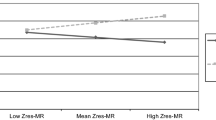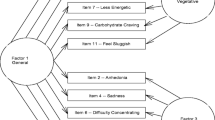Abstract
Research indicates that seasonal fluctuations in vegetative functions (e.g., sleep, appetite, and energy) occur to varying degrees in the general population and a large fluctuation in vegetative functioning is often considered the core of seasonal affective disorder (SAD). The purpose of the present study was to determine if, among those with seasonal changes in vegetative functioning, a cognitive vulnerability to depression is associated with an increased risk for developing the cognitive and affective symptoms of SAD. Results indicate that participants with more dysfunctional attitudes, a more ruminative response style, and a more internal attributional style for negative events report experiencing more severe mood and cognitive symptoms of depression during the winter, controlling for the severity of vegetative symptoms. This was the case both for retrospective reports of typical symptoms and prospective reports of actual symptoms. These results provide support for Young’s dual vulnerability model, in which cognitive factors interact with environmentally mediated biological factors in the pathogenesis of full-symptom SAD, and suggest that cognitively-oriented interventions may be useful as adjunctive or alternative treatments for SAD.
Similar content being viewed by others
Notes
The original authors interpret the results as indicating a seasonal effect in both groups but with the winter scores being similar to the fall scores for the SAD group and the winter scores being similar to the summer scores for the healthy control group, which is not a theoretically meaningful pattern.
References
Abramson, L. Y., Metalsky, G. I., & Alloy, L. B. (1989). Hopelessness depression: A theory-based subtype of depression. Psychological Review, 96, 358–372.
American Psychiatric Association (2000). Diagnostic and statistical manual of mental disorders, 4th ed, Text Revision. Washington, DC: Author.
Beck, A. T., Rush, A. J., Shaw, B. F., & Emery, G. (1979). Cognitive therapy of depression. New York: Guilford.
Beck, A. T., Steer, R. A., & Brown, G. K. (1996). Manual for the Beck depression inventory—II. San Antonio, TX: Psychological Corporation.
Beck, A. T., Ward, C. H., Mendelson, M., Mock J., & Erbaugh, J. (1961). An inventory for measuring depression. Archives of General Psychiatry, 4, 53–63.
Clark, D. M., & Teasdale, J. D. (1985). Constraints of the effects of mood on memory. Journal of Personality and Social Psychology, 48, 1595–1608.
Enns, M. W., Levitan, R. D., Levitt, A. J., Dalton, E. J., & Lam, R. W. (1999). Diagnosis, epidemiology, and pathophysiology. In R. Lam, & A. Levitt, (Eds), Canadian consensus guidelines for the treatment of seasonal affective disorder (pp. 20–36). Canada: Clinical and Academic Publishing.
Farmer, A., Harris, T., Redman, K., Mahmood, A., Sadler, S., & McGuffin, P. (2001). The Cardiff Depression Study: A sib-pair study of dysfunctional attitudes in depressed probands and healthy control subjects. Psychological Medicine, 31, 627–633.
First, M. B., Spitzer, R. L., Gibbon, M., & Williams, J. B. W. (1995). Structured clinical interview for DSM-IV axis I disorders (SCID-Clinician Version). New York: New York State Psychiatric Institute Biometrics Research Department.
Gemar, M. C., Segal, Z. V., Sagrati, S., & Kennedy, S. J. (2001). Mood-induced changes on the implicit association test in recovered depressed patients. Journal of Abnormal Psychology, 110, 282–289.
Gladstone, T. R., & Kaslow, N. J. (1995). Depression and attributions in children and adolescents: A meta-analytic review. Journal of Abnormal Child Psychology, 23, 597–606.
Hammen, C., & Krantz, S. E. (1985). Measures of psychological processes in depression. In E. E. Beckham, & W. R. Leber, (Eds), Handbook of depression: Treatment, assessment, and research (pp. 408–444). Homewood, IL: Dorsey Press.
Hankin, B. L., Abramson, L. Y., & Siler, M. (2001). A prospective test of the hopelessness theory of depression in adolescence. Cognitive Therapy and Research, 25, 607–632.
Hardin, T. A., Wehr, T. A., Brewerton, T., Kasper, S., Berrettini, W., Rabkin, J., & Rosenthal, N. E. (1991). Evaluation of seasonality in six clinical populations and two normal populations. Journal of Psychiatric Research, 25, 755–787.
Hodges, S., & Marks, M. (1998). Cognitive characteristics of seasonal affective disorder: A preliminary investigation. Journal of Affective Disorders, 50, 59–64.
Hollon, S. D., & Kendall, P. C. (1980). Cognitive self-statements in depression: Development of an Automatic Thoughts Questionnaire. Cognitive Therapy and Research, 3, 383–396.
Imber, S. D., Pilkonis, P. A., Sotsky, S. M., Elkin, I., Watkins, J. T., Collins, J. F., Shea, M. T., Leber, W. R., & Glass, D. R. (1990). Mode-specific effects among three treatments of depression. Journal of Consulting and Clinical Psychology, 58, 352–359.
Ingram, R. E. (1984). Toward an information processing analysis of depression. Cognitive Therapy and Research, 8, 443–478.
Kasper, S., Wehr, T. A., Bartko, J. J., Gaist, P. A., & Rosenthal, N. E. (1989). Epidemiological changes in mood and behavior: A telephone survey of Montgomery County, Maryland. Archives of General Psychiatry, 46, 823–833.
Lam, R. W., Buchanan, A., & Remick, R. A. (1989). Seasonal affective disorder—A Canadian sample. Annals of Clinical Psychiatry, 1, 241–245.
Levitan, R. D., Rector, N. A., & Bagby, R. M. (1998). Negative attributional style in seasonal and nonseasonal depression. American Journal of Psychiatry, 155, 428–430.
Madden, P. A. F., Heath, A. C., Rosenthal, N. E., & Martin, N. G. (1996). Seasonal changes in mood and behavior: The role of genetic factors. Archives of General Psychiatry, 53, 47–55.
Martin, M. (1990). On the induction of mood. Clinical Psychology Review, 10, 669–697.
Miranda, J., Gross, J. J., Persons, J., & Hahn, J. (1998). Mood matters: Negative mood induction activates dysfunctional attitudes in women vulnerable to depression. Cognitive Therapy and Research, 22, 363–376.
Murray, G., Allen, N. B., & Trinder, J. (2001). A longitudinal investigation of seasonal variation in mood. Chronobiology International, 18, 875–891.
Nolen-Hoeksema, S. (1991). Responses to depression and their effects on the duration of depressive episodes. Journal of Abnormal Psychology, 100, 569–582.
Nolen-Hoeksema, S., & Morrow, J. (1991). A prospective study of depression and posttraumatic stress symptoms after a natural disaster: The 1989 Loma Prieta earthquake. Journal of Personality and Social Psychology, 61, 115–121.
Nolen-Hoeksema, S., Morrow, J., & Fredrickson, B. L. (1993). Response styles and the duration of episodes of depressed mood. Journal of Abnormal Psychology, 102, 20–28.
Nolen-Hoeksema, S., Parker, L. E., & Larson, J. (1994). Ruminative coping with depressed mood following loss. Journal of Personality and Social Psychology, 67, 92–104.
Partonen, T., & Rosenthal, N. E. (2001). Symptoms and course of illness. In T. Partonen, & A. Magnusson, (Eds), Seasonal affective disorder: Practice and research. Oxford: Oxford University Press.
Peterson, C., Semmel, A., von Baeyer, C., Abramson, L. Y., Metalsky, G. I., & Seligman, M. E. P. (1982). The attributional style questionnaire. Cognitive Therapy and Research, 6, 287–299.
Reardon, A., Young, M. A., & Blodgett, C. (2001, November). Patterns of symptom remission in seasonal affective disorder. Poster presented at the annual meeting of the Society for Research in Psychopathology, Madison, WI.
Rohan, K. J., Lindsey, K. T., Roecklein, K. A., & Lacy, T. J. (2004). Cognitive-behavioral therapy, light therapy, and their combination in treating seasonal affective disorder. Journal of Affective Disorders, 80, 273–283.
Rohan, K. J., Sigmon, S. T., & Dorhofer, D. M. (2003). Cognitive-behavioral factors in seasonal affective disorder. Journal of Consulting and Clinical Psychology, 71, 22–30.
Rosenthal, N. E., Genhart, M., Sack, D. A., Skwerer, R. G., & Wehr, T. A. (1987). Seasonal affective disorder: Relevance for treatment and research of bulimia. In J. L. Hudson, & H. G. Pope, (Eds.), Psychobiology of Bulimia. Washington, D.C.: American Psychiatric Press.
Rosenthal, N. E., Sack, D. A., Gillin, J. C., Lewy, A. J., Goodwin, F. K., Davenport, Y., Muller, P. S., Newsome, D. A., & Wehr, T. A. (1984). Seasonal affective disorder: A description of the syndrome and preliminary findings with light therapy. Archives of General Psychiatry, 41, 72–80.
Schmitt, L., & Young, M. A. (2000, May). Clustering of symptoms across the offset of seasonal affective disorder. Paper presented at the Annual Meeting of the Society for Light Treatment and Biological Rhythms, Evanston, IL.
Segal, Z. V., Gemar, M. C., & Williams, S. (1999). Differential cognitive response to a mood challenge following successful cognitive therapy or pharmacotherapy for unipolar depression. Journal of Abnormal Psychology, 108, 3–10.
Segal, Z. V., & Ingram, R. E. (1994). Mood priming and construct activation in tests of cognitive vulnerability to unipolar depression. Clinical Psychology Review, 14, 663–695.
Spoont, M. R., Depue, R. A., & Krauss, S. S. (1991). Dimensional measurement of seasonal variation in mood and behavior. Psychiatry Research, 39, 269–284.
Steer, R. A., Ball, R., Ranieri, W. F., & Beck, A. T. (1999). Dimensions of the Beck Depression Inventory—II in clinical depressed outpatients. Journal of Clinical Psychology, 55, 117–128.
Treynor, W., Gonzalez, R., & Nolen-Hoeksema, S. (2003). Rumination reconsidered: A psychometric analysis. Cognitive Therapy and Research, 27, 247–259.
Weissman, A. N. (1979). The dysfunctional attitude scale: A validation study (Doctoral dissertation, University of Pennsylvania, 1979). Dissertation Abstracts International, 40(3-B), 1389–1390.
Weissman, A. N., & Beck, A. T. (1978, November). Development and validation of the Dysfunctional Attitude Scale: A preliminary investigation. Paper presented at the meeting of the American Educational Research Association, Toronto, Ontario, Canada.
Whisman, M. A., Miller, I. W., Norman, W. H., & Keitner, G. I. (1991). Cognitive therapy with depressed inpatients: Specific effects on dysfunctional cognitions. Journal of Consulting and Clinical Psychology, 59, 282–288.
Williams, J. B., Link, M. J., Rosenthal, N. E., Amira, L., & Terman, M. (1992). Structured interview guide for the Hamilton Rating Scale for depression—seasonal affective disorder version (SIGH-SAD). New York: New York State Psychiatric Institute.
Yin, P., & Fan, X. (2000). Assessing the reliability of Beck Depression Inventory scores: Reliability generalization across studies. Educational and Psychological Measurement, 60, 201–223.
Young, M. A. (1999). Integrating psychological and physiological mechanisms of SAD: The dual vulnerability model. Biological Rhythms Bulletin, 1, 4–6.
Young, M. A., & Azam, O. A. (2003). Ruminative response style and the severity of seasonal affective disorder. Cognitive Therapy and Research, 27, 223–233.
Young, M. A., Blodgett, C., & Reardon, A. (2003). Measuring seasonality: Psychometric properties of the SPAQ and ISV. Psychiatry Research, 117, 75–83.
Young, M. A., Watel, L. G., Lahmeyer, H. W., & Eastman, C. I. (1991). The temporal onset of individual symptoms in winter depression: Differentiating underlying mechanisms. Journal of Affective Disorders, 22, 191–197.
Author information
Authors and Affiliations
Corresponding author
Rights and permissions
About this article
Cite this article
Enggasser, J.L., Young, M.A. Cognitive Vulnerability to Depression in Seasonal Affective Disorder: Predicting Mood and Cognitive Symptoms in Individuals with Seasonal Vegetative Changes. Cogn Ther Res 31, 3–21 (2007). https://doi.org/10.1007/s10608-006-9076-z
Received:
Accepted:
Published:
Issue Date:
DOI: https://doi.org/10.1007/s10608-006-9076-z




